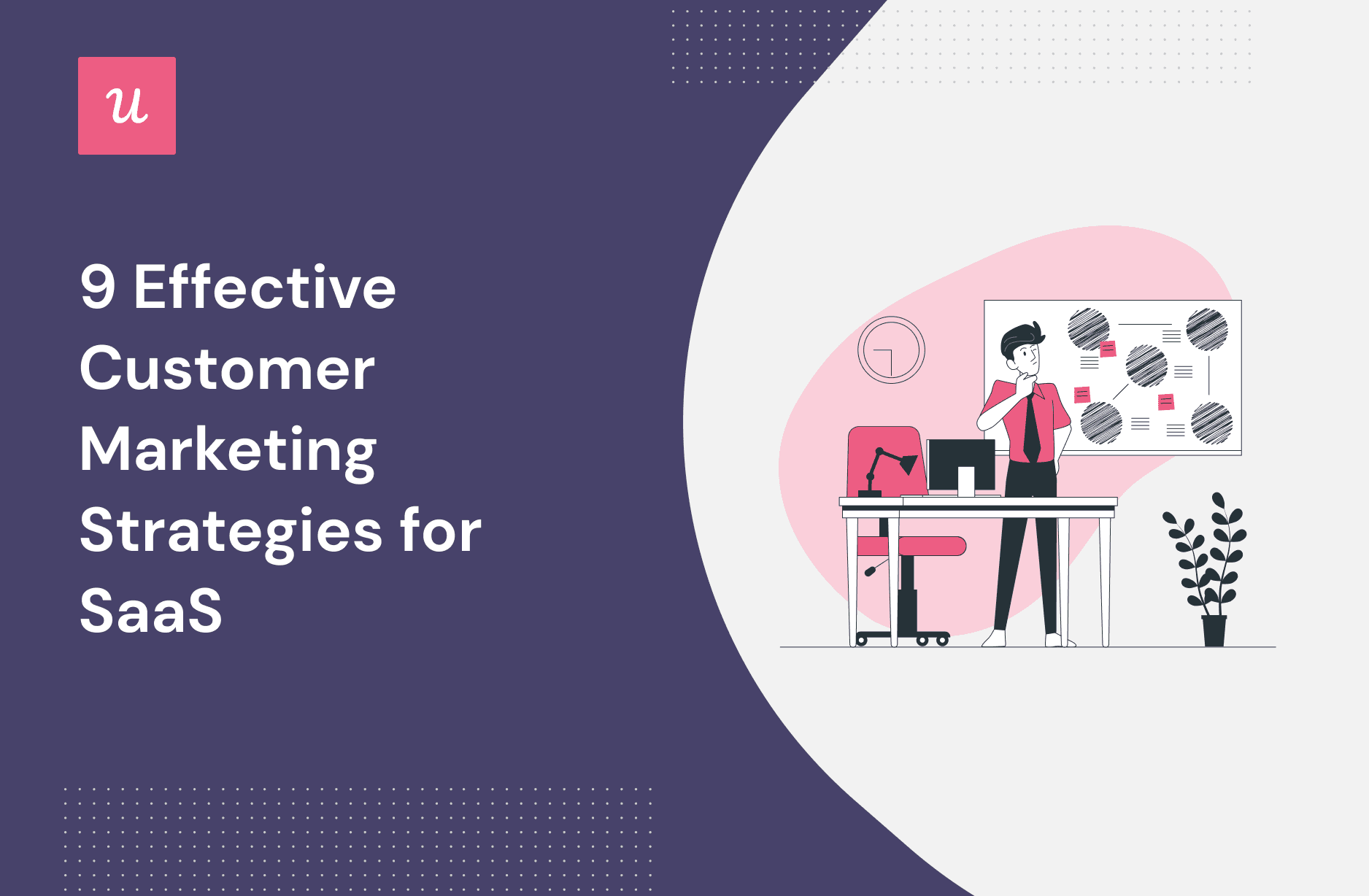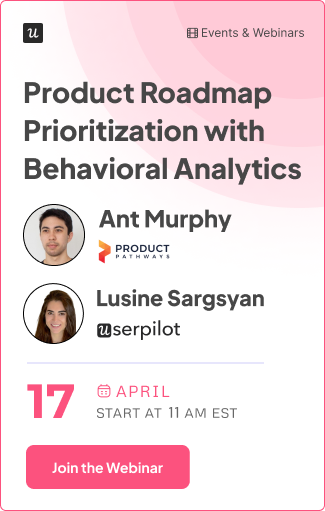9 Effective Customer Marketing Strategies for SaaS

Are you leveraging customer marketing to generate new and sustained business opportunities? Are you getting the most out of your existing customer base?
As product marketers, getting lost in the push for new customers after launching a new product or service is easy.
However, at some point, the cost per customer acquisition starts rising, and churn rates skyrocket. That is why you need something different to maintain sustainable and economic growth.
This article discusses customer marketing, its importance, types, and the best customer marketing strategy for your SaaS business.
TL;DR
- Customer marketing is any form of marketing targetting your existing customers and aimed at fostering loyalty and driving retention.
- Product marketing strategies focus on optimizing the product and its usage while customer marketing strategies focus more on creating user segments and marketing to those segments effectively.
- Successful customer marketing improves the user experience, making it more enjoyable. It also turns customers into advocates, leading to increased revenues.
- You will need to pay attention to different types of customers: active, loyal, discount, need-based, etc.
- You can categorize every customer-driven marketing strategy according to its primary goal: increasing customer satisfaction or boosting the customer’s lifetime value.
Some strategies to help you reach your customer marketing goals include:
- Using the welcome screen to learn more about the user and personalize their experience.
- Mapping the customer success journey to identify the steps, stages, and milestones required for customer success.
- Using onboarding survey responses to segment users according to their characteristics and JTBD.
- Learning more about how users engage with your product and using feature tagging to drive feature discovery and boost engagement.
- Collecting feedback using NPS surveys and proactively improving the user experience based on their feedback.
- Acknowledging and rewarding loyal customers for sticking with – and promoting – your brand.
- Encouraging loyal customers to leave public reviews based on their experiences.
- Providing users with the guidance and resources they need to experience value faster.
- Userpilot helps you better understand your customer and increase their business value. Book a demo today to learn how.
What is customer marketing?
Customer marketing is any marketing aimed at your existing customers, rather than potential customers, as its primary target. Customer marketing focuses on driving customer retention, building customer loyalty, and turning customers into brand ambassadors.
What is a customer marketing strategy?
A customer marketing strategy is any marketing strategy hinged on customer segmentation and engagement. It promotes customer advocacy and leverages the experiences of satisfied customers to drive retention and boost business growth.
Customer marketing vs. product marketing
With existing customers and their experiences at the center of both customer marketing and product marketing strategies, they share several similarities; but the focus of each varies slightly.
Product marketing strategies focus on the product and how it meets customer needs. Product onboarding, feature adoption, and customer feedback collection and integration are integral parts of product marketing.
On the other hand, customer marketing focuses on creating user segments based on available data and effectively marketing new products or services to these segments.
The benefits of customer marketing
Customer marketing is a broad-shaped strategy that encompasses all that you do after a customer signs up, aimed at building quality relationships with customers. Amongst the many benefits of customer marketing are:
- Increased customer loyalty and retention: Customer marketing makes the customer experience more enjoyable. As a result, it increases customer retention rates, turning existing customers into loyal customers.
- Customer advocacy: By boosting customer satisfaction, customer marketing helps turn customers into brand advocates that promote your product or service through word-of-mouth marketing.
- Increased revenue: Ultimately, great customer relationships lead to recurring purchases from your current customers, which leads to increased revenue.
What are the types of customers in marketing?
To effectively market to any customer, you must understand the customer and their relationship with your business. Some types of customers to pay attention to include:
- Active customers: These customers actively use your product or service after the purchase. Although active customers may not be loyal to your brand, they love your product and use it productively.
- Loyal customers: These customers are loyal to your brand, repeatedly coming to you for your product/service, regardless of the available competition.
- Discount customers: The discount customer only ever purchases your product when they find it at less than its full retail price.
- Need-based customers: This customer buys products to serve a specific need. They know what they want and why. Need-based customers are difficult targets for upselling or cross-selling.
Different types of customer marketing
There are two primary goals of any customer marketing strategy:
- Improving customer satisfaction
- Growing the customer’s lifetime value
Every customer marketing strategy can be classified according to which of these goals it pursues. For instance, where upselling and customer retention efforts help boost the customer’s lifetime value, loyalty programs and customer service efforts drive customer satisfaction.
What follows is a complete list of the types of customer marketing efforts that help you achieve either of these goals.

Effective customer marketing strategies to implement
A solid customer-driven marketing strategy enables you to leverage your current customers as marketing assets. But where do you begin? Consider a few strategies to get you started.
Personalize onboarding based on the user’s job to be done
Your first interaction with new customers sets the tone for your ongoing relationship; treat it with care. A good introduction is a two-way affair. It tells the user who you are and how you can serve them, but it also tells you who they are and why they need you.
Create welcome screens for your first communication with new customers. Welcome them with a warm, personalized greeting message, and find out who they are and what goals they want to achieve with your product.

Finally, personalize the user’s experience on the platform using this information. A personalized onboarding experience helps new customers understand your product and how it aids them to achieve customer success.
Map the customer success journey and guide them through each stage
A customer success journey map is a graphic representation of the stages a customer must pass through to succeed with your product. It captures everything that happens between new customers signing up and achieving success.
Start by identifying the different stages of the customer journey. Then, set goals for each customer segment at every stage of their journey. Finally, map them all together into an onboarding playbook.

Armed with this information, you can design an onboarding process that encourages users to follow these steps to reduce friction and achieve success.
Segment users with similar characteristics to provide a better experience
Onboarding surveys give you a preliminary idea of who your users are and what they want to achieve. Segment your customer base, using these responses to provide help according to their needs.
For instance, you could use tooltips to showcase features that users need to achieve their stated JTBD (job to be done).
Userpilot helps you successfully segment your customers using any combination of criteria.

Understand customer engagement with feature tagging
Feature tagging helps you answer questions about your users and how they interact with your product. For instance, how many of your users are using your core and secondary features? How often do they use them?

Once you notice a segment of users lagging behind in the usage of a feature, it’s time to act. First, you may want to find out why. Then, you need to reach out to them with a hotspot/spotlight that encourages feature discovery and adoption.

Collect and act on feedback
At the heart of customer-centric marketing is feedback. Use in-app surveys to collect user feedback regarding your product and measure customer satisfaction.
Create NPS surveys with Userpilot to gauge user sentiment around your product. Who are your detractors? What fuels their negativity? How can you resolve their issues and turn them from detractors to promoters?
Use follow-up questions to identify friction points and desired improvements. Use this information to guide product upgrades that eliminate them.

Reward your existing customers
One way to keep customers happy is to offer them rewards for their loyalty. A well-optimized NPS survey helps you identify your promoters.
You can build simple but effective modals, slideouts, and checklists like the one below code-free with Userpilot to offer your users their rewards.

Drive customers to become brand advocates
Advocate marketing is a great way to cut down marketing budgets while increasing your reach. Encourage delighted customers to share their customer stories and leave public reviews for your product.
Segment users with higher scores; use in-app messaging and modals to prompt them to leave a review. Incentivize users to take out the time to leave these reviews using rewards.

Provide self-service support
For your business to be fully customer-centric, it must offer customers the tools and resources they need to help themselves.
Self-service support provides users with the guidance and resources they need to master your product and navigate difficulties while using it. A resource center relieves you of the need for large support teams while providing on-demand support to users.
A good resource center contains resources in different formats, from video tutorials to webinar recordings, case studies, and much more. It even provides users an option to contact customer support if they need more personalized assistance.

Guide users to adopt your product
Use onboarding tooltips to reveal the next task or activity the user should take to boost product usage and adoption. You can create these tooltips without writing a single line of code, with Userpilot.

How do you measure your customer marketing efforts
How can you tell whether you’re doing a good enough job with customer marketing? With the right onboarding metrics, measuring the success of your customer marketing efforts doesn’t have to be daunting. Consider a few of them:
- Customer lifetime value: This metric tracks the total expected earnings of a paying customer over the length of their relationship with you.
- ROI: The return on investment calculates the profitability of your investment across your marketing channels.
- Cost per lead: How much does it cost you to acquire a single lead? Zero in on the more effective parts of your marketing campaign to bring down costs.
- OKRs: OKRs (Objectives and Key Results) are a collaborative goal-setting methodology that helps you track the progress of your marketing team using measurable goals.
- User journey tracking: User journey analytics help you monitor your users’ digital interactions and map out each customer’s path to conversion.
Set goals with Userpilot for each stage of the user journey and track how they progress across the journey and the friction keeping them from reaching their goals. Use the knowledge you gather to smoothen out the kinks and improve the journey.

Conclusion
Rather than constantly chasing down new prospects, customer marketing helps you optimize the value of your existing customers. It optimizes customer support and success to drive retention, encourage loyalty, and increase revenue through upselling, cross-selling, and referrals.
Userpilot provides you with tools to better understand your customer needs and turn customers into brand ambassadors. Get a Userpilot demo to learn more about these tools and how they help you achieve your goal.

